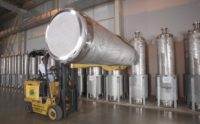In announcing last month broadened criteria for classifying employers as severe safety violators, U.S. Occupational Safety and Health Administration official Douglas Parker singled out a steel fabricator near El Paso, Texas. The U.S. Labor Dept. assistant secretary for occupational safety and health, he posted a blog stating that OSHA had placed Kyoei Steel Ltd. in its severe violators program, which subjects the firm to numerous re-inspections until it is allowed to exit.
A burned hand in October 2021 and an amputated finger last January were among the injuries suffered by employees of Kyoei, wrote Parker. OSHA counted 10 incidents at the company's plant in five years, including five machine-guarding violations. In April, OSHA proposed $364,000 in fines against the fabricator.
While Kyoei officials could not be reached for comment, the company joins other more prominent construction suppliers and contractors already in the program, which currently includes Otis Elevator and PPG Industries.
Under OSHA's announced changes, many more companies could be labeled as severe violators. At least one labor union sees the changes as a boost to workers' safety, but an attorney representing employers thinks there are now too many hazards identified by OSHA that could put a company in the program.
Since OSHA started the program in 2010, it has focused enforcement and inspection resources on employers that either willfully or repeatedly violate federal health and safety laws or fail to correct previous violations. About 700 companies in all industries have landed in the program, including many construction firms.
Previously, an employer could be in the program for failing to meet a limited number of standards considers high hazard. They included fall, amputation and combustible dust; crystalline silica, lead and grain handling—all hazards that OSHA formally emphasizes.
Now, however, OSHA has eliminated the high-emphasis hazard element.
"To fall into [the program] now, an employer merely needs to receive two or more high gravity repeat or willful violations or failure to abate notices, in the same inspection or involving any hazard or standard," wrote Eric Conn, a lawyer who represents employers and writes the OSHA Defense Report. "This is a substantial change that will result in exponentially more employers qualifying" into the severe violators program.
Criteria For Removal
There are other changes to enforcement as well. In the past, a company could be removed from the program three years after the final order date.
But an employer up for removal now must wait until three years after the date of receiving verification that it has abated all program-related hazards. To exit, an employer must consent to an enhanced settlement agreement that includes use of a safety and health management system with seven basic elements in OSHA's recommended practices for such programs.
Ron Meischker, director of industry and labor compliance for the Eastern Atlantic Regional Council of Carpenters, says the changes are a good thing.
“If under the new rules an employer is compliant for three years, that allows you to lower the intensity of inspections they are going to receive," he says. "I think that’s ample incentive for employers to follow the rules and keep workers safe.”
Meischker adds: “Anything that is going to improve worker safety and create employer accountability to keep workers safe is a good thing.”
ABC Seeks Closer Cooperation
Responding to the severe violator program changes, Greg Sizemore, vice president for safety and workforce development at the Associated Builders and Contractors, suggests that a partnership between OSHA and employers is a better idea. OSHA should do a better job promoting its voluntary protection program, he says.
Sizemore adds that such “long-successful cooperative efforts” with employers can prevent companies from ending up in the administration’s severe violators program. “ABC condemns violators who meet the criteria [for the program] and encourages them to improve their safety process to keep the workforce safe,” he says.




Post a comment to this article
Report Abusive Comment